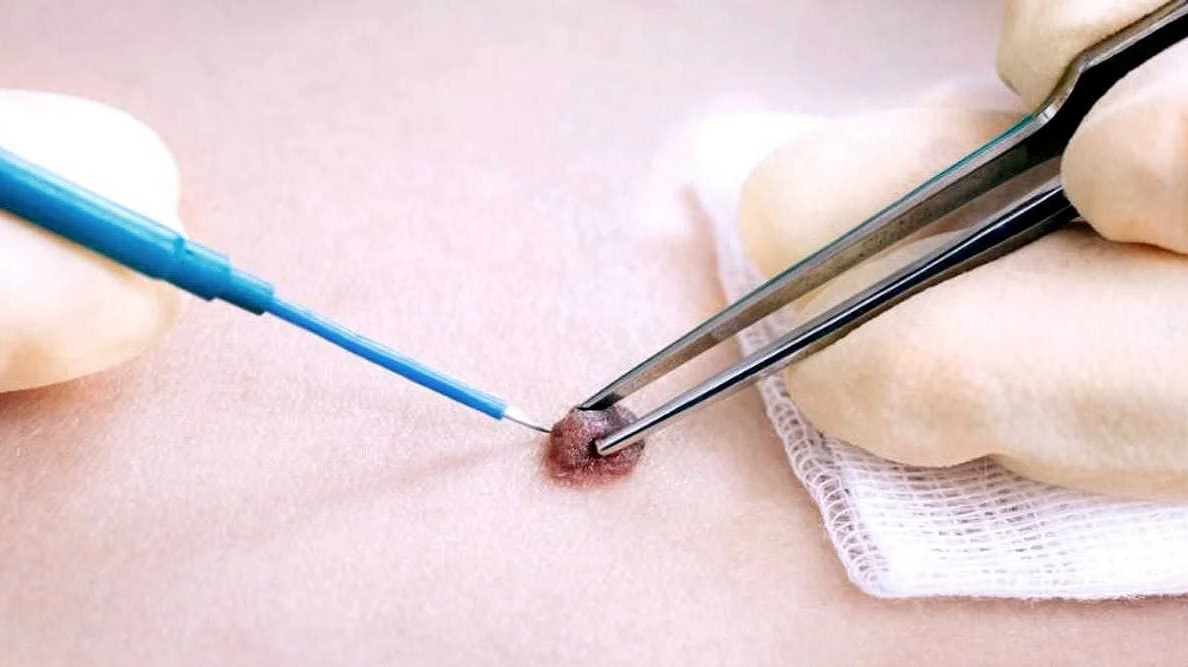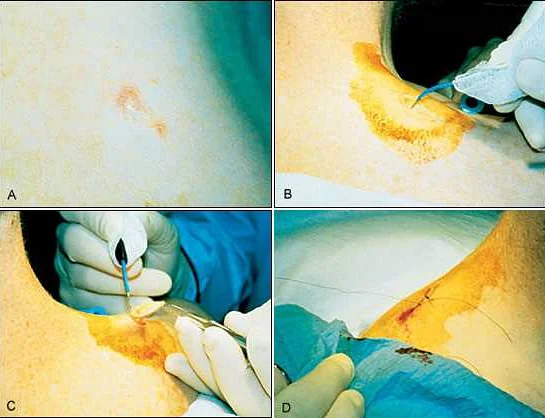Electrocoagulation of papilloma: description, effectiveness, skincare recommendations
Learn about electrocoagulation, a procedure used for the removal of papillomas. Discover its effectiveness and get recommendations for post-cauterization skin care.
Papillomas, also known as skin tags or acrochordons, are benign skin growths that typically appear on the neck, armpits, groin area, or under the breasts. While they are harmless, many individuals may find them unsightly or bothersome. Electrocoagulation is a popular and effective method for removing papillomas, offering a safe and efficient solution.
During the electrocoagulation procedure, a small probe is used to deliver an electric current to the papilloma. This current heats the tissue, causing it to coagulate and effectively seal off the blood vessels that supply the growth. As a result, the papilloma shrinks and eventually falls off, leaving behind a small scab that heals over time.
One of the advantages of electrocoagulation is its minimal invasiveness. The procedure is typically performed under local anesthesia, ensuring that the patient experiences little to no pain. Additionally, the risk of scarring is minimized due to the precision of the electrical current, which targets only the papilloma without damaging the surrounding healthy tissue.
With a success rate of over 90%, electrocoagulation is highly effective in removing papillomas. The procedure can be performed on individuals of all skin types and is suitable for both large and small growths. However, it is important to note that electrocoagulation may not be suitable for individuals with certain medical conditions or those taking specific medications. It is crucial to consult with a dermatologist or healthcare professional before undergoing the procedure.
After electrocoagulation, proper care of the treated area is essential for optimal healing. It is important to keep the area clean and dry, avoiding any excessive friction or irritation. The scab that forms after the procedure should not be picked or scratched, as this can increase the risk of infection and scarring. Applying a topical antibiotic ointment and protecting the area from sun exposure are also recommended to aid in the healing process.
In conclusion, electrocoagulation is a highly effective method for removing papillomas. Its minimal invasiveness, high success rate, and minimal scarring make it a popular choice among individuals seeking papilloma removal. By following proper post-procedure care recommendations, patients can ensure optimal healing and maintenance of their skin’s health. Consultation with a dermatologist or healthcare professional is necessary to determine if electrocoagulation is the right treatment option for an individual’s specific needs.
Description of Electrocoagulation Procedure for Papilloma Removal
Electrocoagulation is a safe and effective procedure used for the removal of papillomas. It involves the use of a high-frequency electrical current to destroy the papilloma by cauterizing the tissue.
During the procedure, the patient is positioned comfortably, and the area around the papilloma is thoroughly cleaned. Local anesthesia may be administered to ensure the patient’s comfort. Once the area is numbed, a small needle-like electrode connected to a high-frequency generator is used to deliver the electrical current to the papilloma.
The electrical current is carefully controlled and applied to the papilloma in short bursts. This causes the tissue to heat up rapidly, resulting in coagulation and destruction of the papilloma. The procedure is relatively quick, with most papillomas being treated in a matter of minutes.
After the electrocoagulation, a small scab may form at the site of the papilloma. This scab will naturally fall off within a week or two, revealing healthy skin underneath. It is important to avoid picking or scratching the scab to prevent infection and scarring.
Following the electrocoagulation procedure, it is recommended to keep the treated area clean and dry. The use of gentle cleansers and moisturizers can help promote healing. It is also important to protect the area from excessive sun exposure and to apply sunscreen with a high SPF when going outside.
If there are multiple papillomas or if the papilloma is particularly large or located in a sensitive area, multiple sessions of electrocoagulation may be required for complete removal. The number of sessions required will be determined by the healthcare professional.
In conclusion, electrocoagulation is a highly effective procedure for the removal of papillomas. It is a quick and safe method that typically results in minimal scarring. Following the procedure, proper skin care measures should be taken to promote healing and prevent complications.
Procedure Steps: Preparation, Application, Aftercare

Electrocoagulation is a minimally invasive procedure that is used to remove papillomas, or skin growths, by using electrical currents to burn and destroy the affected tissue. The procedure is performed by a trained healthcare professional and typically takes less than 30 minutes to complete.
Before the procedure, the patient will need to prepare by ensuring the affected area is clean and free of any creams, lotions, or makeup. The healthcare professional will then apply a local anesthetic to numb the area and minimize any discomfort during the procedure.
During the application phase, the healthcare professional will use a specialized electrocoagulation device to deliver controlled electrical currents to the papilloma. This will cause the tissue to burn and coagulate, effectively removing the growth. The healthcare professional will carefully maneuver the device to ensure the entire papilloma is treated.
After the procedure, the patient will be given instructions for aftercare. This may include applying an antibiotic ointment to the treated area to prevent infection and promote healing. The patient should avoid touching or scratching the area and should keep it clean and dry. It is also important to avoid excessive sun exposure and use sunscreen to protect the treated area.
| Preparation | Clean the affected area and apply a local anesthetic to numb the area. |
| Application | Use a specialized electrocoagulation device to deliver electrical currents and burn the papilloma. |
| Aftercare | Apply antibiotic ointment, avoid touching or scratching the area, keep it clean and dry, and protect it from excessive sun exposure. |
Overall, electrocoagulation is an effective treatment option for removing papillomas. The procedure steps involve preparation, application, and aftercare, and it is important for patients to follow the recommended skin care instructions to ensure proper healing and minimize the risk of complications.
Effectiveness of Electrocoagulation in Papilloma Treatment

Electrocoagulation is a highly effective method for treating papillomas. This non-invasive procedure involves the use of electrical current to cauterize and remove the papilloma tissue. The electrical current is delivered through a specialized probe, which is applied directly to the papilloma.
During the procedure, the electrical current generates heat, which destroys the blood vessels supplying the papilloma. This leads to coagulation of the tissue, causing the papilloma to shrink and eventually fall off. Electrocoagulation is effective in removing papillomas of various sizes, from small lesions to larger ones.
One of the major advantages of electrocoagulation is its high success rate. Studies have shown that this technique has a success rate of over 90% in completely removing papillomas. The procedure is generally quick and can be performed in an outpatient setting, without the need for general anesthesia.
Another benefit of electrocoagulation is its minimal scarring. Unlike surgical methods, electrocoagulation does not require any incisions or sutures. This reduces the risk of visible scars and allows for a quicker healing process. After the procedure, it is common for the treated area to form a scab, which will eventually fall off, leaving behind healthy skin.
It is important to note that electrocoagulation may cause some discomfort during the procedure, such as a mild burning sensation. However, this can be managed with the use of topical anesthesia or numbing cream. After the procedure, patients may experience some redness, swelling, and scabbing, but these are temporary and should subside within a few days.
Overall, electrocoagulation is a highly effective and safe method for treating papillomas. It offers high success rates, minimal scarring, and quick recovery times. It is important to consult with a qualified healthcare professional to determine if electrocoagulation is the right treatment option for you.
Benefits of Electrocoagulation over Other Methods

Electrocoagulation is a highly effective and efficient method for the removal of papillomas. It offers several advantages over other methods such as surgical excision, cryotherapy, and laser treatment. Here are some of the key benefits of electrocoagulation:
| Non-invasive: Unlike surgical excision, electrocoagulation is a non-invasive procedure that requires no incisions or sutures. This reduces the risk of infection, scarring, and other complications associated with invasive techniques. |
| Precision: Electrocoagulation allows for precise targeting of the papillomas, ensuring that only the affected tissue is treated. This minimizes damage to the surrounding healthy skin and promotes faster healing. |
| Minimal pain and discomfort: Compared to cryotherapy and laser treatment, electrocoagulation is generally less painful and causes minimal discomfort. The procedure can be performed under local anesthesia, and patients usually experience only mild discomfort during and after the treatment. |
| Quick and efficient: Electrocoagulation is a relatively quick procedure that can be completed in a single session. It offers efficient removal of papillomas, with minimal downtime and recovery period. Patients can resume their daily activities immediately after the procedure. |
| Cost-effective: Compared to surgical excision and laser treatment, electrocoagulation is a cost-effective option for the removal of papillomas. It is a relatively simple procedure that does not require expensive equipment or extensive follow-up care. |
Overall, electrocoagulation provides a safe, effective, and convenient alternative to other methods for the removal of papillomas. It offers numerous benefits in terms of minimal invasiveness, precision, pain reduction, efficiency, and cost-effectiveness. Consult with a dermatologist to determine if electrocoagulation is the right treatment option for you.